Special Report
Every State's Rules for Staying at Home and Social Distancing

Published:
Last Updated:

While some states are beginning to lift stay-at-home orders and allow nonessential businesses to open as the spread of the novel coronavirus has slowed, most of the United States is still in lockdown. COVID-19 has so far killed more than 61,000 people in the U.S. as of April 30. More than a million people nationwide have tested positive.
To slow the spread of the coronavirus and save lives by keeping the local health care systems from being overwhelmed, each state has implemented its own set of rules — at different times and at varying limitations. In some states sheltering in place is the law, in others staying home is merely a recommendation.
To determine each state’s social distancing measures and restrictions on movement, 24/7 Wall St. reviewed executive orders from governors since the first COVID-19 case was confirmed in the United States at the end of January.
A minority of people, albeit a very vocal one, have started protesting the orders. They are pressing for an end to the restrictions even though the coronavirus continues to spread across the United States. Here are the states where COVID-19 is spreading the fastest right now.
While many people may feel confined and resist giving up their right to go outside or travel freely, there is some evidence that social distancing limitations are working and the rate of daily new infections is slowing.
Click here to see every states rules for staying at home and social distancing
Click here to read our methodology

The stay-at-home order ends on April 30. A new “Safer at Home” order will be in effect through May 15. Some businesses such as retail stores will be allowed to reopen at 50% capacity but will be subject to sanitation and social distancing guidelines. Elective medical procedures will be allowed to resume. Beaches will reopen but no groups of more than 10 people will be allowed. Alabama schools are closed for the remainder of the 2019-20 school year.
Alaska
> Confirmed COVID-19 cases as of April 29: 48 per 100,000 — 3rd lowest (total: 351)
> COVID-19 related deaths as of April 29: 1 per 100,000 — 3rd lowest (total: 9)
> Tests as of April 29: 2,317 per 100,000 — 12th highest (total: 17,089)
> Days between first case on 3/12/2020 and statewide stay-at-home effective date (3/28/2020): 16
> Population: 737,438
The stay-at-home order expired on April 21. On April 24, the state government allowed nonessential businesses to reopen for regular business hours. Restrictions vary by sector. For example, there can be no waiting lines in places providing personal services like hair salons. Many travel and fishing restrictions have also been lifted. K-12 schools are closed for the rest of the school year.
[in-text-ad]

Arizona
> Confirmed COVID-19 cases as of April 29: 97 per 100,000 — 12th lowest (total: 6,948)
> COVID-19 related deaths as of April 29: 4 per 100,000 — 18th lowest (total: 293)
> Tests as of April 29: 940 per 100,000 — the lowest (total: 67,438)
> Days between first case on 1/26/2020 and statewide stay-at-home effective date (3/31/2020): 65
> Population: 7,171,646
The stay-at-home order ends on April 30, unless extended. The governor has said he would make a decision by the end of the week whether to extend it. Residents can only leave their places of residence for essential activities, such as grocery shopping or obtaining necessary supplies and services for the family or pets. Elective medical procedures would be allowed to resume May 1 with restrictions. K-12 schools are closed for the rest of the school year.
Arkansas
> Confirmed COVID-19 cases as of April 29: 104 per 100,000 — 14th lowest (total: 3,127)
> COVID-19 related deaths as of April 29: 2 per 100,000 — 7th lowest (total: 57)
> Tests as of April 29: 1,437 per 100,000 — 17th lowest (total: 43,321)
> Days between first case on 3/11/2020 and statewide stay-at-home effective date (No order issued as of April 20): No order issued as of Apr. 29
> Population: 3,013,825
There was no statewide stay-at-home order as of April 28. However, gatherings are restricted to no more than 10 people. Businesses that require significant person-to-person interaction are closed. The governor has said the state has met some but not all federal guidelines to start reopening in phases starting May 4. Schools are closed until further notice.
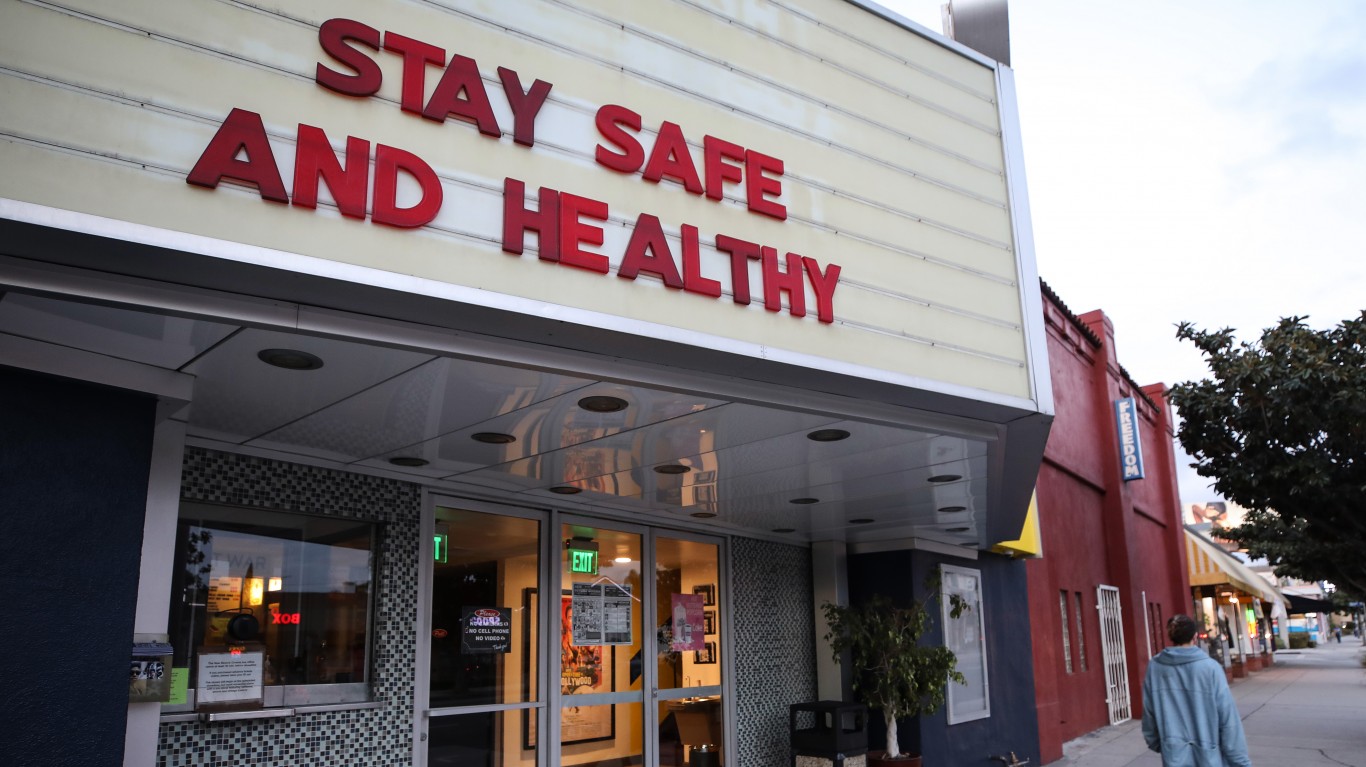
California
> Confirmed COVID-19 cases as of April 29: 117 per 100,000 — 18th lowest (total: 46,445)
> COVID-19 related deaths as of April 29: 5 per 100,000 — 22nd lowest (total: 1873)
> Tests as of April 29: N/A
> Days between first case on 1/25/2020 and statewide stay-at-home effective date (3/19/2020): 54
> Population: 39,557,045
A stay-at-home order has been in effect since March 19 and will remain so until further notice. There is a plan for a phased reopening of the economy, but there is no set date yet. Restrictions will first be lifted for child care centers and lower-risk workplaces, such as retail, manufacturing, and offices where working remotely is not possible. Schools are closed through the rest of the school year.
[in-text-ad-2]

Colorado
> Confirmed COVID-19 cases as of April 29: 251 per 100,000 — 13th highest (total: 14,316)
> COVID-19 related deaths as of April 29: 13 per 100,000 — 13th highest (total: 736)
> Tests as of April 29: 1,178 per 100,000 — 8th lowest (total: 67,094)
> Days between first case on 3/5/2020 and statewide stay-at-home effective date (3/26/2020): 21
> Population: 5,695,564
The stay-at-home order expired April 26. A phased opening of the economy started on April 27. The state entered a “safer at home” phase, where residents are recommended to stay home but not required to by law. Social distancing is strongly encouraged. Grocery stores, firearm stores, marijuana dispensaries, and gas stations can stay open. Retail businesses can reopen with curbside delivery. Elective medical procedures and personal training has resumed. Starting May 4, all offices will be allowed to reopen at 50% workforce.
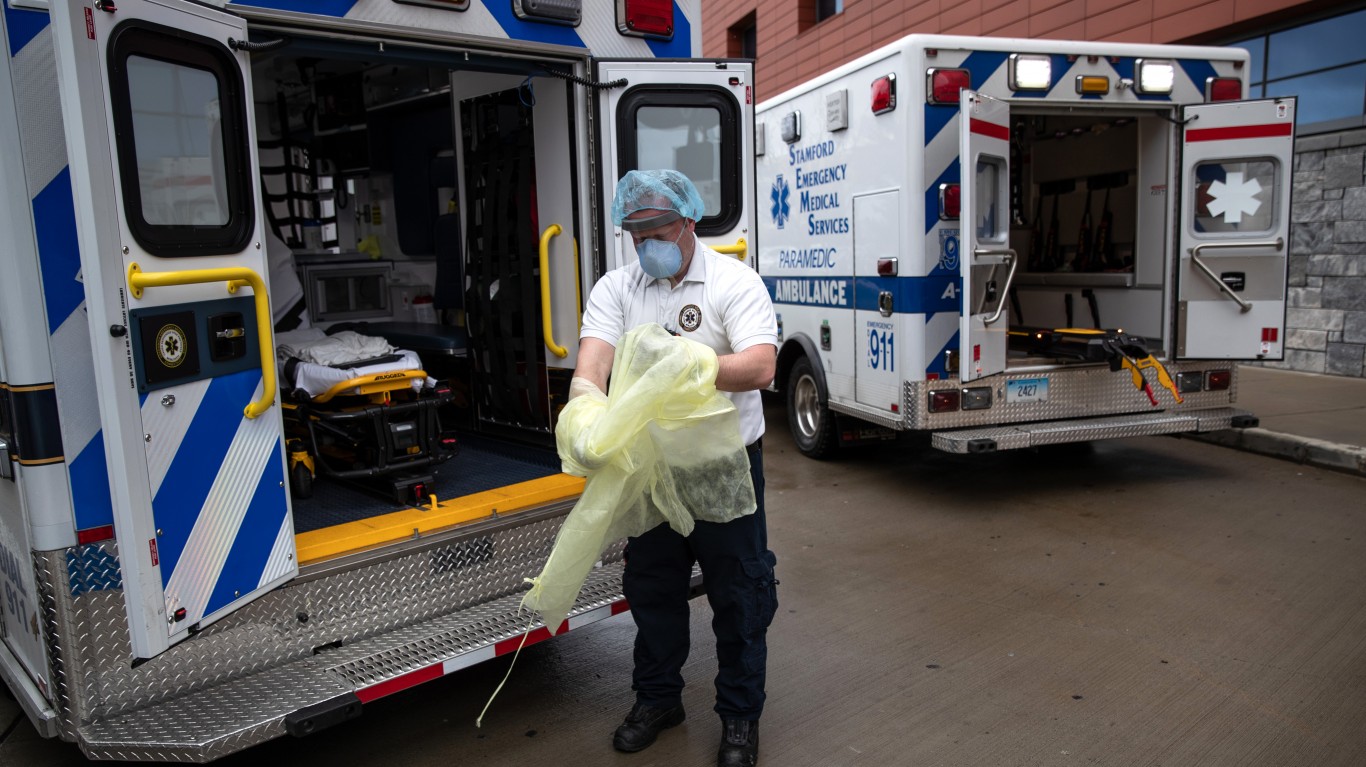
Connecticut
> Confirmed COVID-19 cases as of April 29: 736 per 100,000 — 5th highest (total: 26,312)
> COVID-19 related deaths as of April 29: 58 per 100,000 — 3rd highest (total: 2089)
> Tests as of April 29: 2,596 per 100,000 — 8th highest (total: 92,745)
> Days between first case on 3/8/2020 and statewide stay-at-home effective date (3/23/2020): 15
> Population: 3,572,665
The stay-at-home order is in effect until May 20. Plans are to start reopening in June. Grocery stores operate at half capacity. “Safe stores” guidelines are mandated, with every other register line out of service. A 6-foot minimum distance between people is required outdoors. Parking capacity is limited at certain parks and walk-ins are banned to limit the number of visitors. Restaurants are still open for delivery or takeout.
[in-text-ad]
Delaware
> Confirmed COVID-19 cases as of April 29: 473 per 100,000 — 7th highest (total: 4,575)
> COVID-19 related deaths as of April 29: 14 per 100,000 — 10th highest (total: 137)
> Tests as of April 29: N/A
> Days between first case on 3/11/2020 and statewide stay-at-home effective date (3/24/2020): 13
> Population: 967,171
The stay-at-home order requires that people remain in their homes and avoid going out in public unless they are engaged in an “essential activity” or “essential travel” until May 15 or until the health threat is eliminated. When out, people must maintain at least a 6-foot distance from each other. All beaches are closed except for people exercising or walking their dogs. People can still go out to get groceries, exercise, take care of others, and other essential activities. Schools will be closed through the rest of the school year.
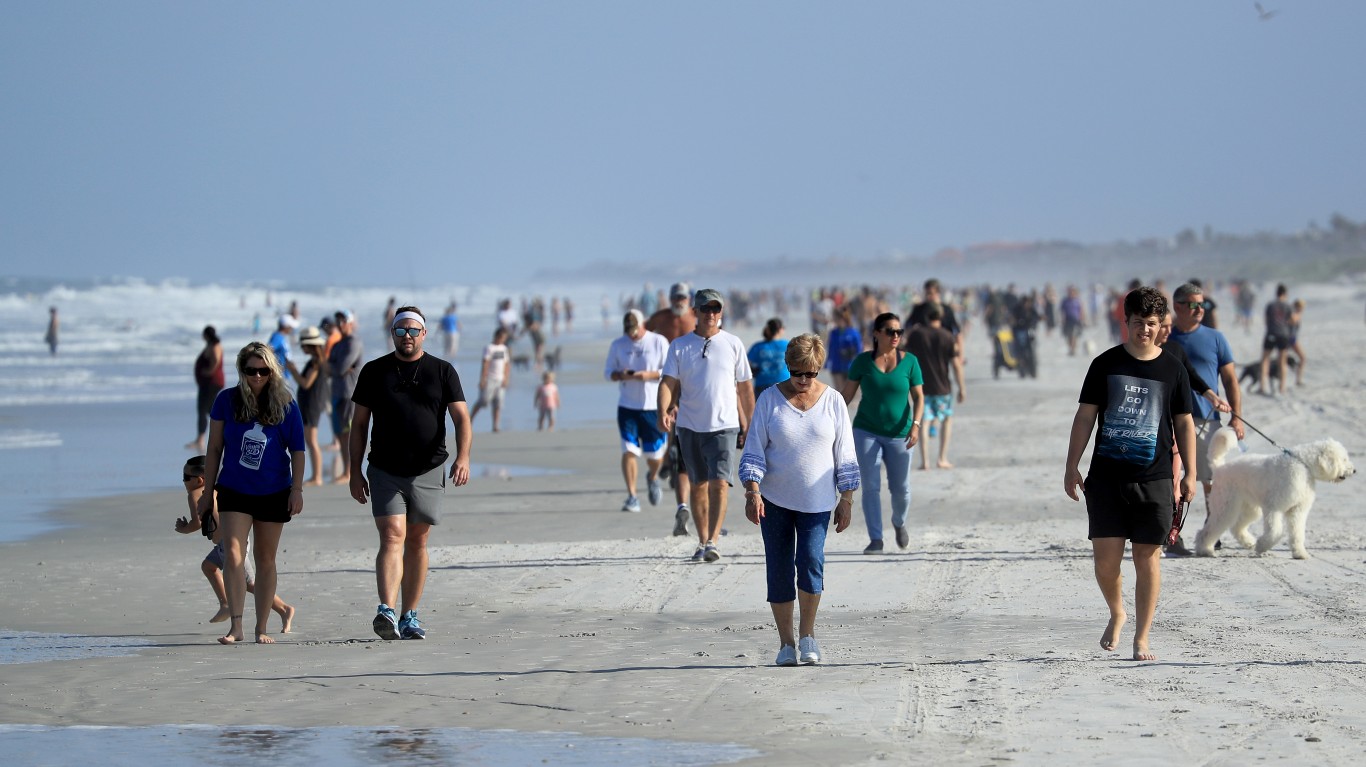
Florida
> Confirmed COVID-19 cases as of April 29: 154 per 100,000 — 22nd highest (total: 32,846)
> COVID-19 related deaths as of April 29: 5 per 100,000 — 21st highest (total: 1171)
> Tests as of April 29: 1,731 per 100,000 — 18th highest (total: 368,651)
> Days between first case on 3/1/2020 and statewide stay-at-home effective date (4/3/2020): 33
> Population: 21,299,325
Florida will start lifting social distancing guidelines on May 4. The stay-at-home order is in effect until April 30. There are no clear plans for reopening after that but the governor has said the state will open methodically, in phases. Beaches reopened for “essential activities” in parts of the state on April 17. Senior citizens and individuals with significant underlying medical conditions must stay at home. K-12 schools are closed for the rest of the school year.
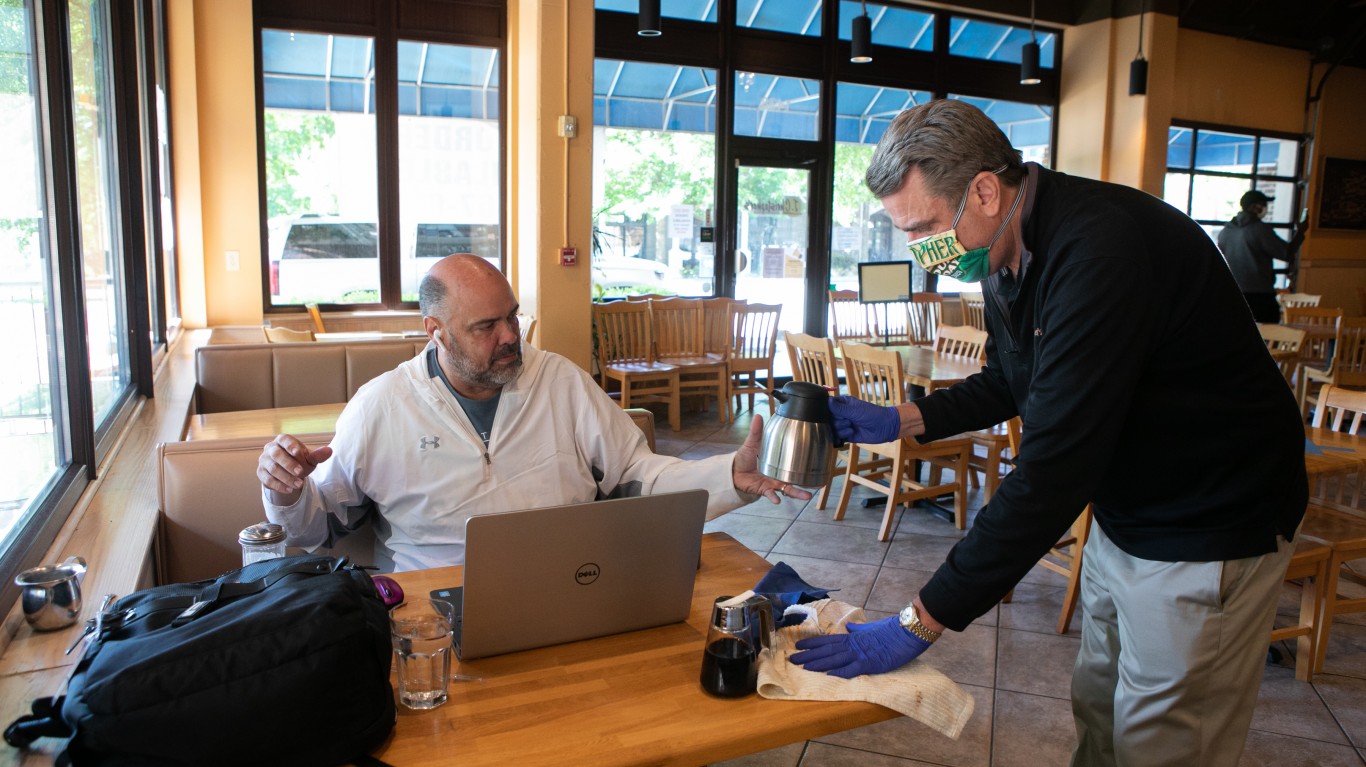
Georgia
> Confirmed COVID-19 cases as of April 29: 236 per 100,000 — 15th highest (total: 24,854)
> COVID-19 related deaths as of April 29: 10 per 100,000 — 15th highest (total: 1036)
> Tests as of April 29: 1,333 per 100,000 — 16th lowest (total: 140,223)
> Days between first case on 3/2/2020 and statewide stay-at-home effective date (4/3/2020): 32
> Population: 10,519,475
A shelter-in-place order in effect at least until April 30. Some businesses, including gyms and hair salons, are now allowed to reopen (even though many opted to remain closed). Elective surgeries resumed on April 24. Child care facilities are open but take no more than 10 people, including teachers.
[in-text-ad-2]
Hawaii
> Confirmed COVID-19 cases as of April 29: 43 per 100,000 — 2nd lowest (total: 609)
> COVID-19 related deaths as of April 29: 1 per 100,000 — the lowest (total: 16)
> Tests as of April 29: N/A
> Days between first case on 3/6/2020 and statewide stay-at-home effective date (3/25/2020): 19
> Population: 1,420,491
People must quarantine themselves for two weeks if traveling between islands or risk fines up to $5,000 and a year in prison. Only people seeking medical attention may leave their quarantine zones, which is the location residents have specified to be their quarantine zone on the mandatory State of Hawaii Department of Agriculture Plants and Animals Declaration Form. Stay-at-home, work-at-home orders are in effect until May 31. The state government will be taking a “phased-in” approach to reopening the economy. Schools are closed through the rest of the school year.
Idaho
> Confirmed COVID-19 cases as of April 29: 109 per 100,000 — 16th lowest (total: 1,917)
> COVID-19 related deaths as of April 29: 3 per 100,000 — 15th lowest (total: 58)
> Tests as of April 29: 1,143 per 100,000 — 7th lowest (total: 20,052)
> Days between first case on 3/13/2020 and statewide stay-at-home effective date (3/25/2020): 12
> Population: 1,754,208
The stay-at-home order expired at the end of April. Some nonessential businesses and houses of worship can reopen on May 1 but have to “prepare operational plans” that include limits on the number of people in a business at a time. The first stage of the reopening plan is set for May 1 through May 15. Places of worship can open if they adhere to strict physical distancing. Day care centers and camps can also reopen.
[in-text-ad]
Illinois
> Confirmed COVID-19 cases as of April 29: 378 per 100,000 — 9th highest (total: 48,102)
> COVID-19 related deaths as of April 29: 17 per 100,000 — 8th highest (total: 2125)
> Tests as of April 29: 1,901 per 100,000 — 16th highest (total: 242,189)
> Days between first case on 1/24/2020 and statewide stay-at-home effective date (3/21/2020): 57
> Population: 12,741,080
A shelter-in-place order is in effect at least through May 30. Schools are to remain closed until the end of the school year. Some restrictions will be loosened starting May 1, including resuming elective surgeries, golfing, allowing curbside service at retail stores, letting nurseries and garden centers reopen.
Indiana
> Confirmed COVID-19 cases as of April 29: 248 per 100,000 — 14th highest (total: 16,588)
> COVID-19 related deaths as of April 29: 13 per 100,000 — 11th highest (total: 901)
> Tests as of April 29: 1,303 per 100,000 — 14th lowest (total: 87,181)
> Days between first case on 3/6/2020 and statewide stay-at-home effective date (3/24/2020): 18
> Population: 6,691,878
The stay-at-home order expires May 1, and the governor won’t decide before then whether to extend it. Daycares remain open. State parks remain open, but playgrounds are closed. Gyms and fitness centers are closed, but exercising outdoors is permitted as long as people maintain 6-foot physical distancing. Some businesses, like dentists, greenhouses, nurseries, and pet groomers, are allowed to reopen with restrictions. More restrictions may be eased in early May.
Iowa
> Confirmed COVID-19 cases as of April 29: 202 per 100,000 — 17th highest (total: 6,376)
> COVID-19 related deaths as of April 29: 4 per 100,000 — 20th lowest (total: 136)
> Tests as of April 29: 1,262 per 100,000 — 13th lowest (total: 39,823)
> Days between first case on 3/8/2020 and statewide stay-at-home effective date: No order issued as of Apr. 29
> Population: 3,156,145
There was no statewide stay-at-home order as of April 28. Nonessential businesses are closed at least until April 30. Anyone who refuses to limit social gatherings could face misdemeanor charges. Schools are closed through the rest of the school year. Businesses and churches in 77 of Iowa’s 99 counties will be allowed to reopen. Restaurants, fitness centers, retail stores, and malls can reopen Friday at 50% capacity in mostly rural countries.
[in-text-ad-2]

Kansas
> Confirmed COVID-19 cases as of April 29: 120 per 100,000 — 20th lowest (total: 3,491)
> COVID-19 related deaths as of April 29: 4 per 100,000 — 19th lowest (total: 124)
> Tests as of April 29: N/A
> Days between first case on 3/7/2020 and statewide stay-at-home effective date (3/30/2020): 23
> Population: 2,911,510
A temporary, statewide stay-home order is in effect until May 3. Residents can only go out to see a doctor, buy groceries, or care for elderly relatives. Outdoor activities are allowed only if people maintain a distance of 6 feet from one another. Schools are closed through the rest of the school year.

Kentucky
> Confirmed COVID-19 cases as of April 29: 98 per 100,000 — 13th lowest (total: 4,375)
> COVID-19 related deaths as of April 29: 5 per 100,000 — 24th lowest (total: 225)
> Tests as of April 29: N/A
> Days between first case on 3/6/2020 and statewide stay-at-home effective date (3/26/2020): 20
> Population: 4,468,402
The stay-at-home order is in effect until further notice. Travel from Kentucky to other states is limited. Residents can leave the state only to care for loved ones, see a doctor, go to work, if they have a court order, or to get groceries. If people leave for other reasons, they have to self-quarantine for 14 days. “Phase one” of the state’s gradual reopening began on April 27 when nonessential medical services were allowed to resume with restrictions.
[in-text-ad]
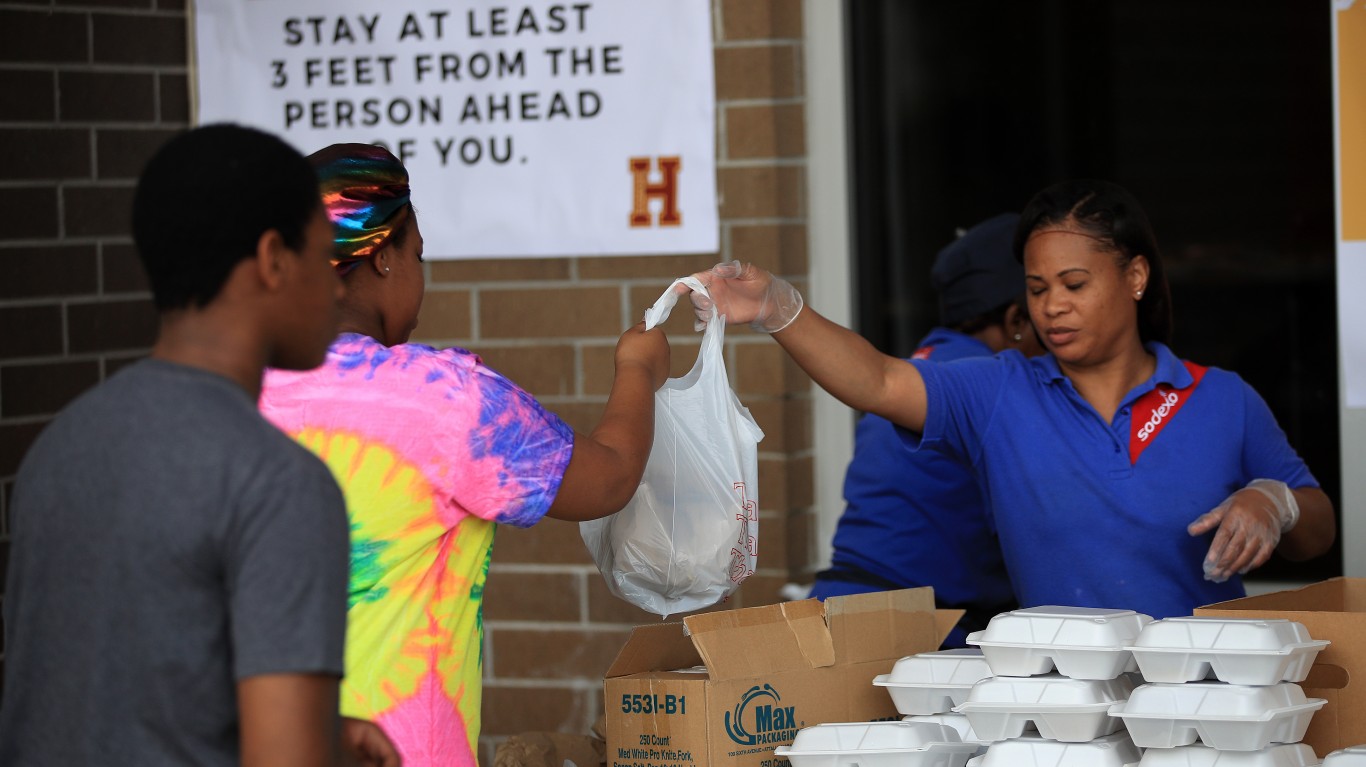
Louisiana
> Confirmed COVID-19 cases as of April 29: 586 per 100,000 — 6th highest (total: 27,286)
> COVID-19 related deaths as of April 29: 38 per 100,000 — 5th highest (total: 1758)
> Tests as of April 29: 3,243 per 100,000 — 4th highest (total: 151,108)
> Days between first case on 3/9/2020 and statewide stay-at-home effective date (3/23/2020): 14
> Population: 4,659,978
An order directing all Louisiana residents to shelter at home and limit movements outside beyond essential needs is in effect until May 15. Everyone in Louisiana should wear masks when in public. Residents can only work from home unless they are providing essential services. Nonessential businesses are closed to the public. Banks, gas stations and veterinary services are open. Outdoor exercise is allowed as long as people maintain 6-foot distancing. Playgrounds are closed.
Maine
> Confirmed COVID-19 cases as of April 29: 78 per 100,000 — 8th lowest (total: 1,040)
> COVID-19 related deaths as of April 29: 4 per 100,000 — 17th lowest (total: 51)
> Tests as of April 29: N/A
> Days between first case on 3/12/2020 and statewide stay-at-home effective date (4/2/2020): 21
> Population: 1,338,404
An executive order requiring travelers to the state to self quarantine for 14 days is in effect at least until May 31. All lodging businesses are suspended. Everyone is required to stay home at all times unless for an essential job or an essential personal reason. Residents will be able to visit businesses, such as hair salons and barbershops, and participate in activities under stage one of the reopening, which begins May 1. Drive-in movies, stay-in-your-vehicle religious services and golf will be allowed.

Maryland
> Confirmed COVID-19 cases as of April 29: 333 per 100,000 — 11th highest (total: 20,113)
> COVID-19 related deaths as of April 29: 15 per 100,000 — 9th highest (total: 929)
> Tests as of April 29: N/A
> Days between first case on 3/5/2020 and statewide stay-at-home effective date (3/30/2020): 25
> Population: 6,042,718
The stay-at-home order is in effect until terminated by the governor. This may happen in early May. An executive order is in effect to wear face coverings in any retail business or on public transportation. Breaking the rules can result in fines or jail time. Businesses deemed essential, including auto repair shops and certain manufacturers, can remain open. People can hunt, fish, and crab for food, but follow social distancing guidelines.
[in-text-ad-2]
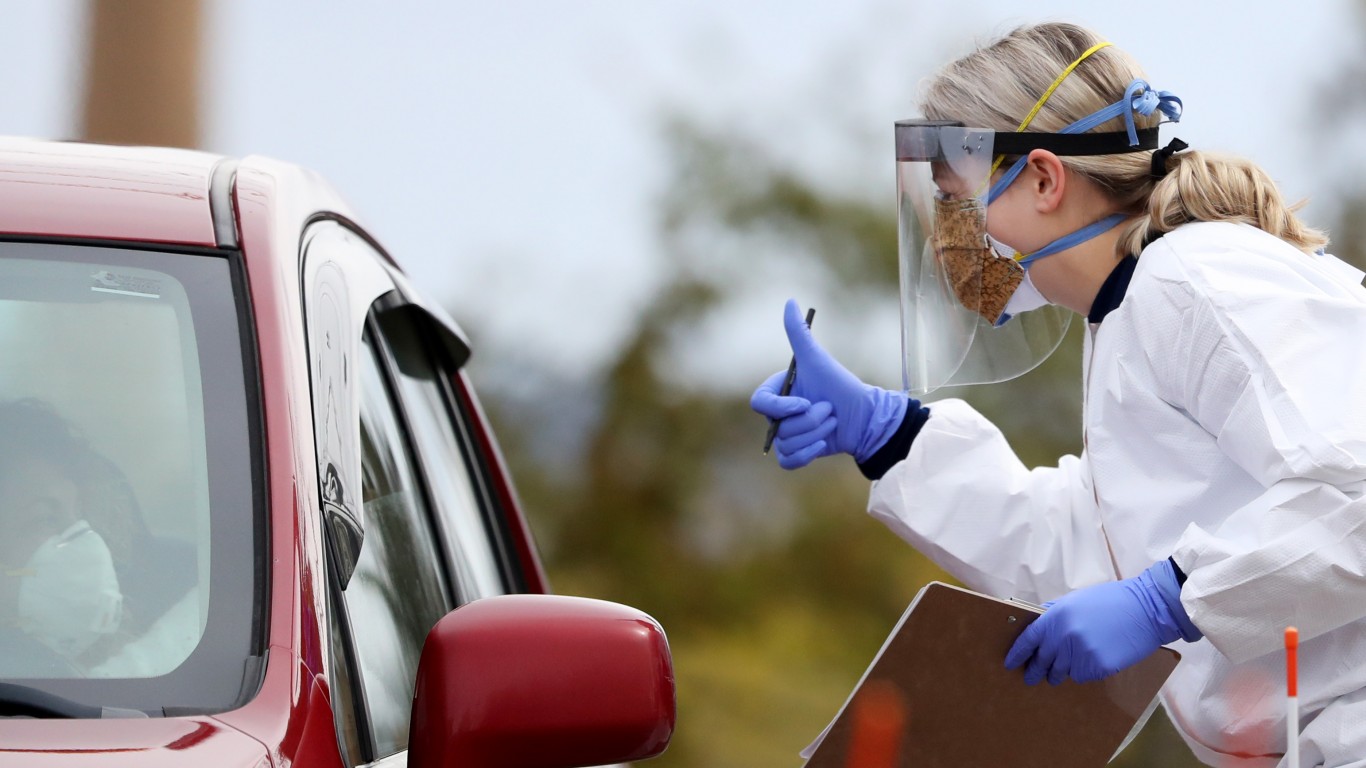
Massachusetts
> Confirmed COVID-19 cases as of April 29: 845 per 100,000 — 3rd highest (total: 58,302)
> COVID-19 related deaths as of April 29: 46 per 100,000 — 4th highest (total: 3153)
> Tests as of April 29: 3,687 per 100,000 — 3rd highest (total: 254,500)
> Days between first case on 2/1/2020 and statewide stay-at-home effective date (3/24/2020): 52
> Population: 6,902,149
A stay-at-home order and an order for nonessential businesses and organizations for in-person operations to remain closed has been extended until May 18. Gatherings of more than 10 people are prohibited. Medical marijuana shops are still open, but recreational marijuana shops are closed. Schools are closed through the rest of the school year, and day care centers are closed until the end of June.
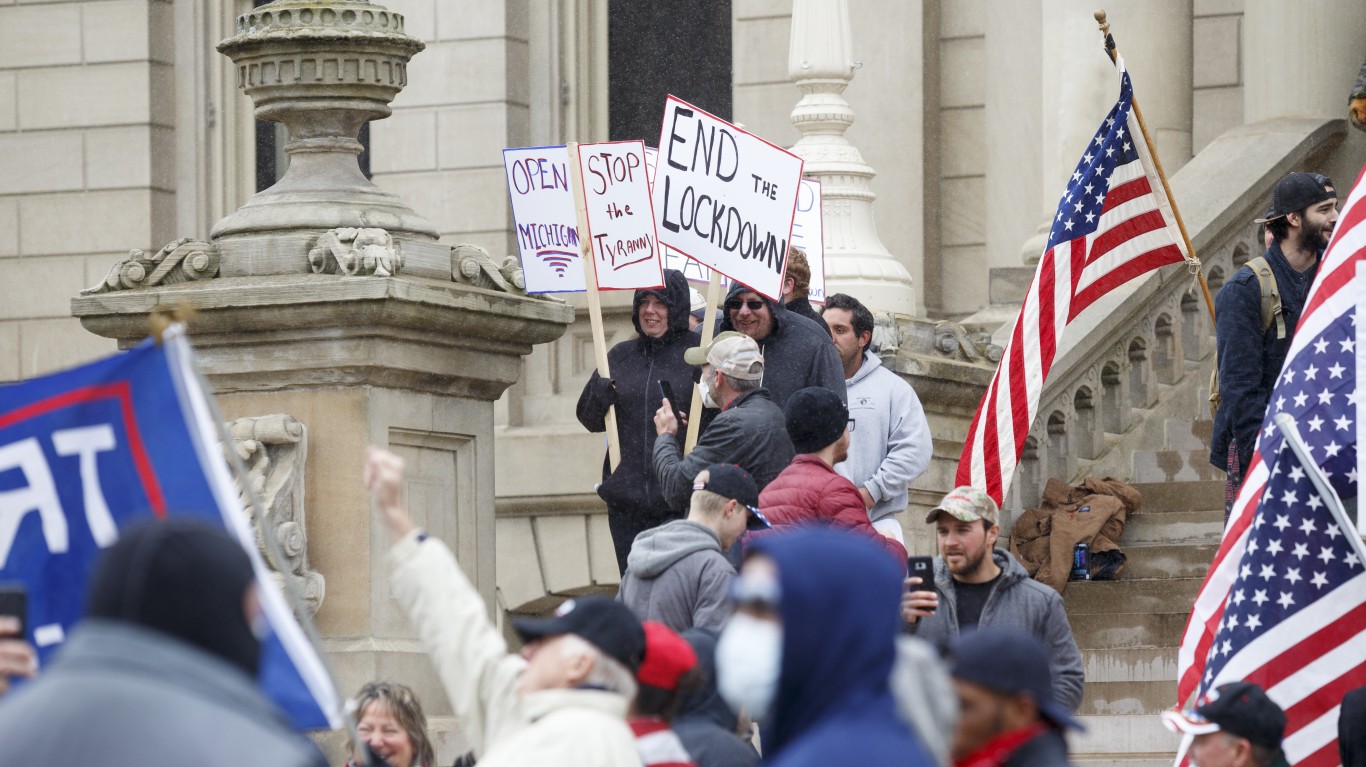
Michigan
> Confirmed COVID-19 cases as of April 29: 393 per 100,000 — 8th highest (total: 39,262)
> COVID-19 related deaths as of April 29: 36 per 100,000 — 6th highest (total: 3567)
> Tests as of April 29: N/A
> Days between first case on 3/10/2020 and statewide stay-at-home effective date (3/24/2020): 14
> Population: 9,995,915
Residents can be criminally penalized for breaking social distancing rules. The stay-at-home order has been extended and is in effect at least until May 15. Restrictions on activities such as boating and golfing have been eased. Large retailer stores are now allowed to resume selling nonessential items.
[in-text-ad]

Minnesota
> Confirmed COVID-19 cases as of April 29: 75 per 100,000 — 7th lowest (total: 4,181)
> COVID-19 related deaths as of April 29: 5 per 100,000 — 22nd highest (total: 301)
> Tests as of April 29: 1,138 per 100,000 — 6th lowest (total: 63,829)
> Days between first case on 3/6/2020 and statewide stay-at-home effective date (3/27/2020): 21
> Population: 5,611,179
The stay-at-home order was extended until May 3. People can still leave their homes to pick up essential items such as groceries or food, prescriptions, and gas, to relocate for safety reasons, or go to work if their job is deemed essential. Schools are closed for the rest of the school year. Some recreational activities, including golfing, boating, fishing, hunting and hiking have been allowed to resume since April 18.
Mississippi
> Confirmed COVID-19 cases as of April 29: 212 per 100,000 — 16th highest (total: 6,342)
> COVID-19 related deaths as of April 29: 8 per 100,000 — 16th highest (total: 239)
> Tests as of April 29: 2,157 per 100,000 — 15th highest (total: 64,412)
> Days between first case on 3/11/2020 and statewide stay-at-home effective date (4/3/2020): 23
> Population: 2,986,530
The shelter-in-place order expired on April 27. Some nonessential businesses like florists and clothing stores can start delivery or curbside pickup. Now, only medically vulnerable people are required to stay home. Retail businesses can reopen at no more than 50% of their store capacity. Places that cannot avoid sustained person-to-person contact, such as theme parks, salons, or gyms, are to remain closed.
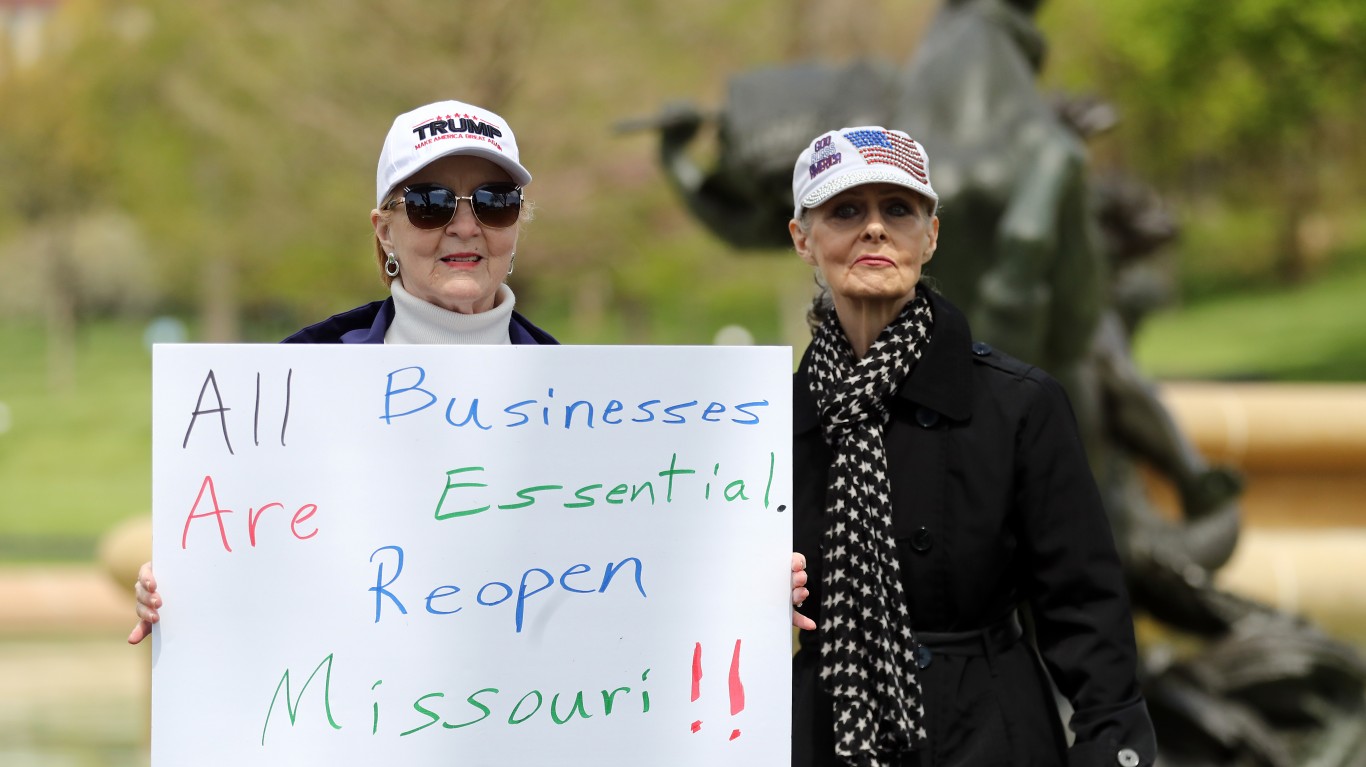
Missouri
> Confirmed COVID-19 cases as of April 29: 119 per 100,000 — 19th lowest (total: 7,303)
> COVID-19 related deaths as of April 29: 5 per 100,000 — 25th lowest (total: 314)
> Tests as of April 29: 1,257 per 100,000 — 12th lowest (total: 77,037)
> Days between first case on 3/7/2020 and statewide stay-at-home effective date (4/6/2020): 30
> Population: 6,126,452
The stay-at-home order, in effect until May 4, will not be extended. After that, all businesses may reopen following social distancing guidelines. Restaurants, manufacturing plants, gyms, hair salons, and churches will be able to resume activities. Sporting events and social gatherings can resume, though local governments can impose stricter limitations. Kansas City’s stay-at-home order is scheduled to remain in effect through May 15.
[in-text-ad-2]
Montana
> Confirmed COVID-19 cases as of April 29: 42 per 100,000 — the lowest (total: 451)
> COVID-19 related deaths as of April 29: 1 per 100,000 — 5th lowest (total: 15)
> Tests as of April 29: 1,242 per 100,000 — 10th lowest (total: 13,191)
> Days between first case on 3/13/2020 and statewide stay-at-home effective date (3/28/2020): 15
> Population: 1,062,305
The shelter-in-place order expired April 24. A phased opening started on April 27. Churches resumed Sunday services, and retailers reopened with social distancing guidelines in place. Schools have the option to return to in-classroom instruction beginning May 7, but several districts continue with remote instruction.
Nebraska
> Confirmed COVID-19 cases as of April 29: 175 per 100,000 — 20th highest (total: 3,374)
> COVID-19 related deaths as of April 29: 3 per 100,000 — 13th lowest (total: 55)
> Tests as of April 29: 1,234 per 100,000 — 9th lowest (total: 23,798)
> Days between first case on 2/17/2020 and statewide stay-at-home effective date: No order issued as of Apr. 29
> Population: 1,929,268
There was no statewide stay-at-home order as of April 28. Schools are closed through the rest of the school year. Gatherings of more than 10 people are prohibited. Child care centers are open but they have to follow the 10-person guidance. Restrictions in 59 of Nebraska’s 93 counties, including the Omaha area, will be relaxed starting May 4. In-person church services may resume with some limitations.
[in-text-ad]

Nevada
> Confirmed COVID-19 cases as of April 29: 159 per 100,000 — 21st highest (total: 4,821)
> COVID-19 related deaths as of April 29: 7 per 100,000 — 18th highest (total: 225)
> Tests as of April 29: 1,323 per 100,000 — 15th lowest (total: 40,135)
> Days between first case on 3/5/2020 and statewide stay-at-home effective date (4/1/2020): 27
> Population: 3,034,392
A stay-at-home order, which also extends to closure of nonessential businesses, gaming and schools, is in effect through May 15, though some restrictions will be lifted starting May. Nevadans must not leave their homes for nonessential activities. Public gatherings of 10 or more people are in effect. Outdoor exercise is allowed as long as people maintain 6-foot physical distancing.

New Hampshire
> Confirmed COVID-19 cases as of April 29: 148 per 100,000 — 24th highest (total: 2,010)
> COVID-19 related deaths as of April 29: 4 per 100,000 — 21st lowest (total: 60)
> Tests as of April 29: N/A
> Days between first case on 3/2/2020 and statewide stay-at-home effective date (3/27/2020): 25
> Population: 1,356,458
Until May 4, residents must stay home or in their place of residence except for essential needs, but only provided that social distancing protocols are observed. Schools are closed in the state for the rest of the school year. There is a temporary prohibition on scheduled gatherings of 10 or more attendees. All state beaches along the Seacoast are closed. There are expectations that the stay-at-home order will remain in effect in a modified form. The governor won’t make an announcement at least until Friday.

New Jersey
> Confirmed COVID-19 cases as of April 29: 1,278 per 100,000 — 2nd highest (total: 113,856)
> COVID-19 related deaths as of April 29: 72 per 100,000 — 2nd highest (total: 6442)
> Tests as of April 29: 2,358 per 100,000 — 11th highest (total: 210,043)
> Days between first case on 3/4/2020 and statewide stay-at-home effective date (3/21/2020): 17
> Population: 8,908,520
Nonessential businesses, including casinos, are closed. A stay-at-home order is in effect indefinitely. Child care centers are closed except for the children of essential workers. Restaurants and bars are closed except for takeout or delivery. Grocery stores, medical marijuana dispensaries, gas stations, and convenience stores are among the retail businesses that can stay open. State and county parks are closed.
[in-text-ad-2]
New Mexico
> Confirmed COVID-19 cases as of April 29: 142 per 100,000 — 25th lowest (total: 2,974)
> COVID-19 related deaths as of April 29: 5 per 100,000 — 24th highest (total: 110)
> Tests as of April 29: 2,947 per 100,000 — 7th highest (total: 61,745)
> Days between first case on 3/11/2020 and statewide stay-at-home effective date (3/24/2020): 13
> Population: 2,095,428
A stay-at-home order is in effect through May 15 at least. Going outdoors is allowed if social distancing rules are followed. State parks remain closed. People traveling to the state must self-isolate. Schools are closed throughout the remainder of the school year.
New York
> Confirmed COVID-19 cases as of April 29: 1,510 per 100,000 — the highest (total: 295,106)
> COVID-19 related deaths as of April 29: 90 per 100,000 — the highest (total: 17638)
> Tests as of April 29: 4,324 per 100,000 — 2nd highest (total: 844,994)
> Days between first case on 3/1/2020 and statewide stay-at-home effective date (3/22/2020): 21
> Population: 19,542,209
A stay-at-home order is in effect until May 15. The governor will extend it in some counties. Fines for breaking social distancing measures were raised to $1,000. Residents must stay home, expect to get essential services, and even then they must stay at least 6 feet apart. All nonessential businesses are closed. Schools are closed at least until May 15 but schools in New York City are closed throughout the rest of the school year. Restaurants can only serve food or beverage for off-premises consumption until further notice.
[in-text-ad]
North Carolina
> Confirmed COVID-19 cases as of April 29: 92 per 100,000 — 11th lowest (total: 9,568)
> COVID-19 related deaths as of April 29: 3 per 100,000 — 14th lowest (total: 342)
> Tests as of April 29: 1,086 per 100,000 — 5th lowest (total: 112,752)
> Days between first case on 3/3/2020 and statewide stay-at-home effective date (3/30/2020): 27
> Population: 10,383,620
The stay-at-home order, which also prevents gatherings of more than 10 people, is in effect until at least May 8. It’s not clear how long the ban on in-person dining at restaurants would be in effect. Public schools are closed through May 15.
North Dakota
> Confirmed COVID-19 cases as of April 29: 130 per 100,000 — 21st lowest (total: 991)
> COVID-19 related deaths as of April 29: 2 per 100,000 — 11th lowest (total: 19)
> Tests as of April 29: 3,121 per 100,000 — 6th highest (total: 23,723)
> Days between first case on 3/11/2020 and statewide stay-at-home effective date: No order issued as of Apr. 29
> Population: 760,077
There was no statewide stay-at-home order as of April 28. However, visitation to long-term care facilities is suspended and all nonessential businesses are closed at least until April 30. Schools are closed until further notice but some facilities will be allowed to reopen in May. Some businesses will be allowed to open, but safety measures such as daily disinfection and limits on the number of customers will remain in place.
Ohio
> Confirmed COVID-19 cases as of April 29: 143 per 100,000 — 25th highest (total: 16,769)
> COVID-19 related deaths as of April 29: 7 per 100,000 — 19th highest (total: 799)
> Tests as of April 29: N/A
> Days between first case on 3/9/2020 and statewide stay-at-home effective date (3/23/2020): 14
> Population: 11,689,442
The stay-at-home order will expire on May 1. After that, the state will begin to reopen in a phased-in approach. Health procedures that do not require an overnight stay in the hospital may resume as well as dental and veterinary services. Beginning on May 4, manufacturing, distribution, construction businesses, and offices may reopen. Retail stores can reopen on May 12. Face coverings will be required.
[in-text-ad-2]
Oklahoma
> Confirmed COVID-19 cases as of April 29: 86 per 100,000 — 9th lowest (total: 3,410)
> COVID-19 related deaths as of April 29: 5 per 100,000 — 23rd highest (total: 207)
> Tests as of April 29: N/A
> Days between first case on 3/6/2020 and statewide stay-at-home effective date: No order issued as of Apr. 29
> Population: 3,943,079
No statewide stay-at-home order has been issued as of April 28 except for older people and those who have severe preexisting conditions. They have to stay home at least until May 6. Tulsa, Oklahoma City, and Norman have issued stay-at-home orders. Previously suspended elective surgeries were allowed to resume after April 24. Schools are closed for the rest of the academic year.
Oregon
> Confirmed COVID-19 cases as of April 29: 57 per 100,000 — 4th lowest (total: 2,385)
> COVID-19 related deaths as of April 29: 2 per 100,000 — 9th lowest (total: 99)
> Tests as of April 29: 1,247 per 100,000 — 11th lowest (total: 52,242)
> Days between first case on 2/28/2020 and statewide stay-at-home effective date (3/23/2020): 24
> Population: 4,190,713
A stay-at-home order is in effect until further notice. Gatherings of more than 25 people are banned. Nonessential social and recreational gatherings are allowed if people keep a distance of at least 6 feet. People violating the order are subject to penalties. All pools, skate parks, outdoor courts, and playgrounds are closed. Nonurgent medical procedures can restart on May 1. Schools are closed for the rest of the school year.
[in-text-ad]
Pennsylvania
> Confirmed COVID-19 cases as of April 29: 338 per 100,000 — 10th highest (total: 43,264)
> COVID-19 related deaths as of April 29: 13 per 100,000 — 12th highest (total: 1716)
> Tests as of April 29: N/A
> Days between first case on 3/6/2020 and statewide stay-at-home effective date (4/1/2020): 26
> Population: 12,807,060
A stay-at-home order in effect until May 8. Trout fishing season is open as long as people follow social distancing guidelines. Outdoor exercise is allowed as long as people maintain 6-foot physical distancing. Construction work can resume on May 1. The governor is expected to lift the stay-at-home order after it expires and ease other restrictions in the least-impacted parts of the state.
Rhode Island
> Confirmed COVID-19 cases as of April 29: 750 per 100,000 — 4th highest (total: 7,926)
> COVID-19 related deaths as of April 29: 23 per 100,000 — 7th highest (total: 239)
> Tests as of April 29: 5,457 per 100,000 — the highest (total: 57,693)
> Days between first case on 3/1/2020 and statewide stay-at-home effective date (3/28/2020): 27
> Population: 1,057,315
The stay-at-home order was extended until May 8. Quarantine restrictions on people returning to Rhode Island from other states and those returning by air are in place. People can go out to go to work, if they need to travel for medical treatment, or obtain necessities. Gatherings of more than five people are banned. All non-critical retail businesses are closed. Schools are closed for the rest of the school year.
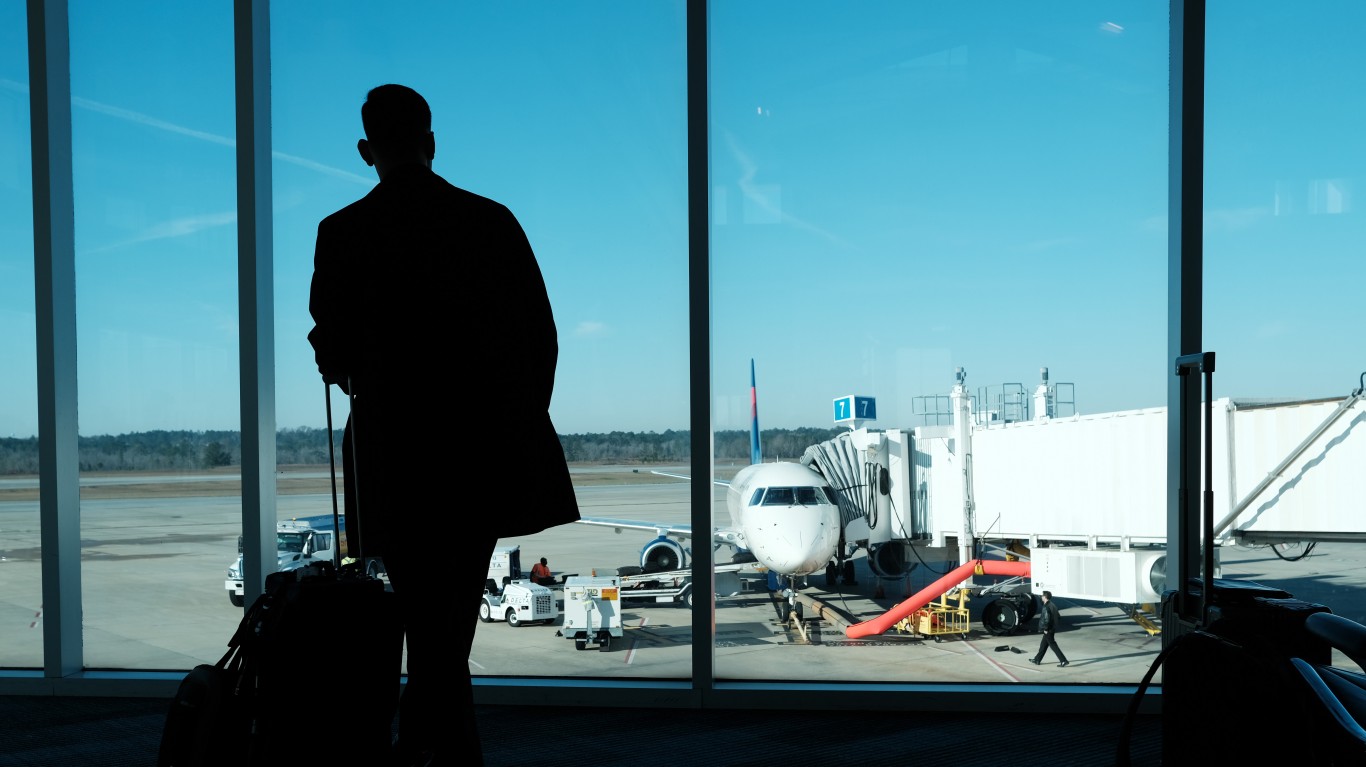
South Carolina
> Confirmed COVID-19 cases as of April 29: 113 per 100,000 — 17th lowest (total: 5,735)
> COVID-19 related deaths as of April 29: 4 per 100,000 — 16th lowest (total: 192)
> Tests as of April 29: 1,045 per 100,000 — 3rd lowest (total: 53,115)
> Days between first case on 3/6/2020 and statewide stay-at-home effective date (4/6/2020): 31
> Population: 5,084,127
The stay-at-home will last as long as the state is under a state of emergency, which has been extended until May 12. People can leave for obtaining necessary supplies, obtaining essential services, attending religious services, or exercising. Anyone out and not performing essential duties is subject to a misdemeanor criminal charge, punishable by up to 30 days in jail. Public beaches can remain open, though many have not. Nonessential businesses such as flea markets, department stores and boutiques were allowed to reopen after April 21.
[in-text-ad-2]

South Dakota
> Confirmed COVID-19 cases as of April 29: 262 per 100,000 — 12th highest (total: 2,313)
> COVID-19 related deaths as of April 29: 1 per 100,000 — 4th lowest (total: 11)
> Tests as of April 29: 1,883 per 100,000 — 17th highest (total: 16,612)
> Days between first case on 3/10/2020 and statewide stay-at-home effective date: No order issued as of Apr. 29
> Population: 882,235
There was no official stay-at-home order as of April 28. People are encouraged to stay home and not gather in groups of 10 or more. Any enclosed businesses should offer alternative services to comply with CDC guidance. People, who are outside, must be at least 6 feet apart. All businesses are encouraged to suspend daily business in the interest of public safety. Schools are closed in the state through the rest of the year.

Tennessee
> Confirmed COVID-19 cases as of April 29: 148 per 100,000 — 23rd highest (total: 10,052)
> COVID-19 related deaths as of April 29: 3 per 100,000 — 12th lowest (total: 188)
> Tests as of April 29: 2,392 per 100,000 — 10th highest (total: 161,926)
> Days between first case on 3/5/2020 and statewide stay-at-home effective date (3/31/2020): 26
> Population: 6,770,010
Residents are required to stay home unless they are carrying out essential activities. The order is in effect until April 30. Many businesses will be allowed to open after that. State parks reopened April 24. Restaurants are allowed to open for dine-in service with reduced capacity.
[in-text-ad]
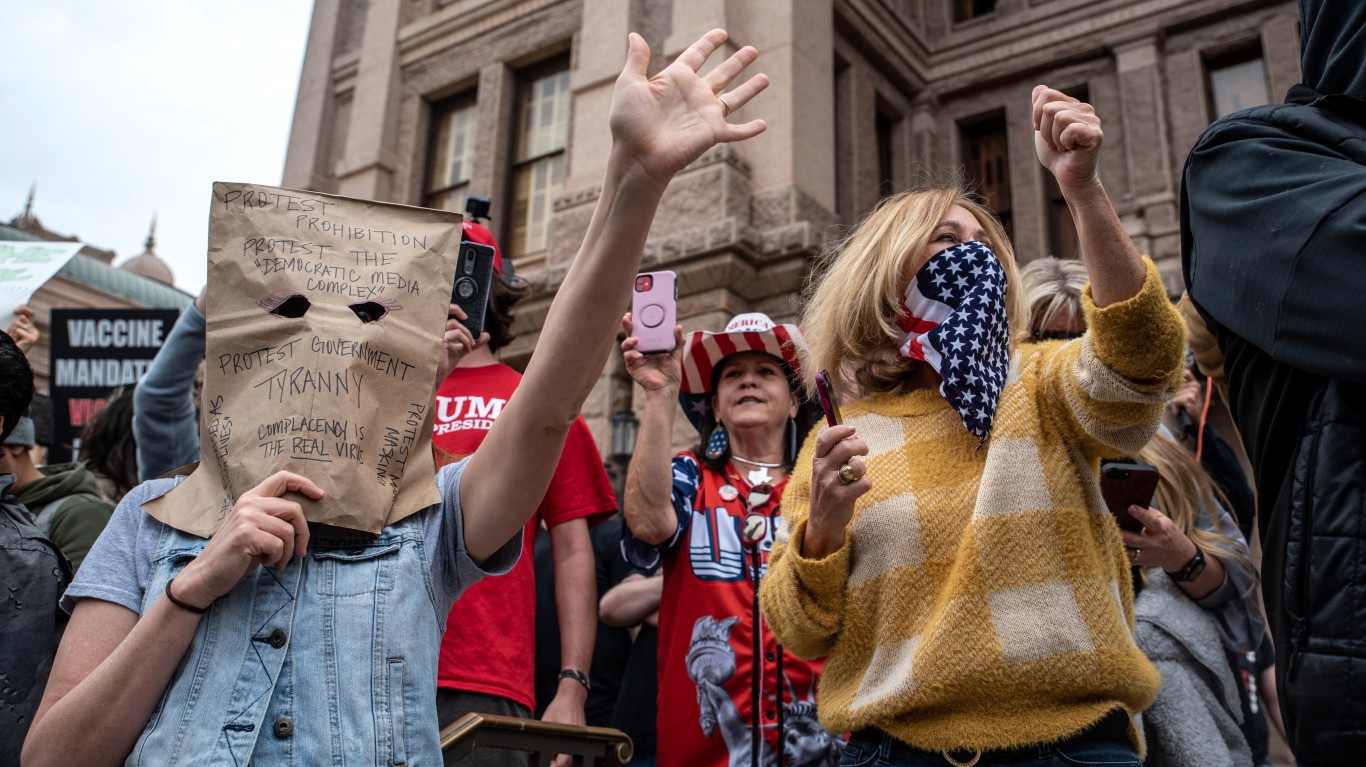
Texas
> Confirmed COVID-19 cases as of April 29: 91 per 100,000 — 10th lowest (total: 26,171)
> COVID-19 related deaths as of April 29: 2 per 100,000 — 10th lowest (total: 690)
> Tests as of April 29: 1,047 per 100,000 — 4th lowest (total: 300,384)
> Days between first case on 2/12/2020 and statewide stay-at-home effective date (4/2/2020): 50
> Population: 28,701,845
A stay-at-home order is in effect until April 30 with exceptions for essential activities like going to the grocery store, pharmacy or bank, and for working at a business that provides an essential service. Hunting, fishing, or exercising outside are still permitted as long as social distancing measures are taken. State parks started reopening on April 20, and some stores were allowed to start offering “retail to go” on April 24. Face coverings are still required. State schools will remain closed for the rest of the school year.
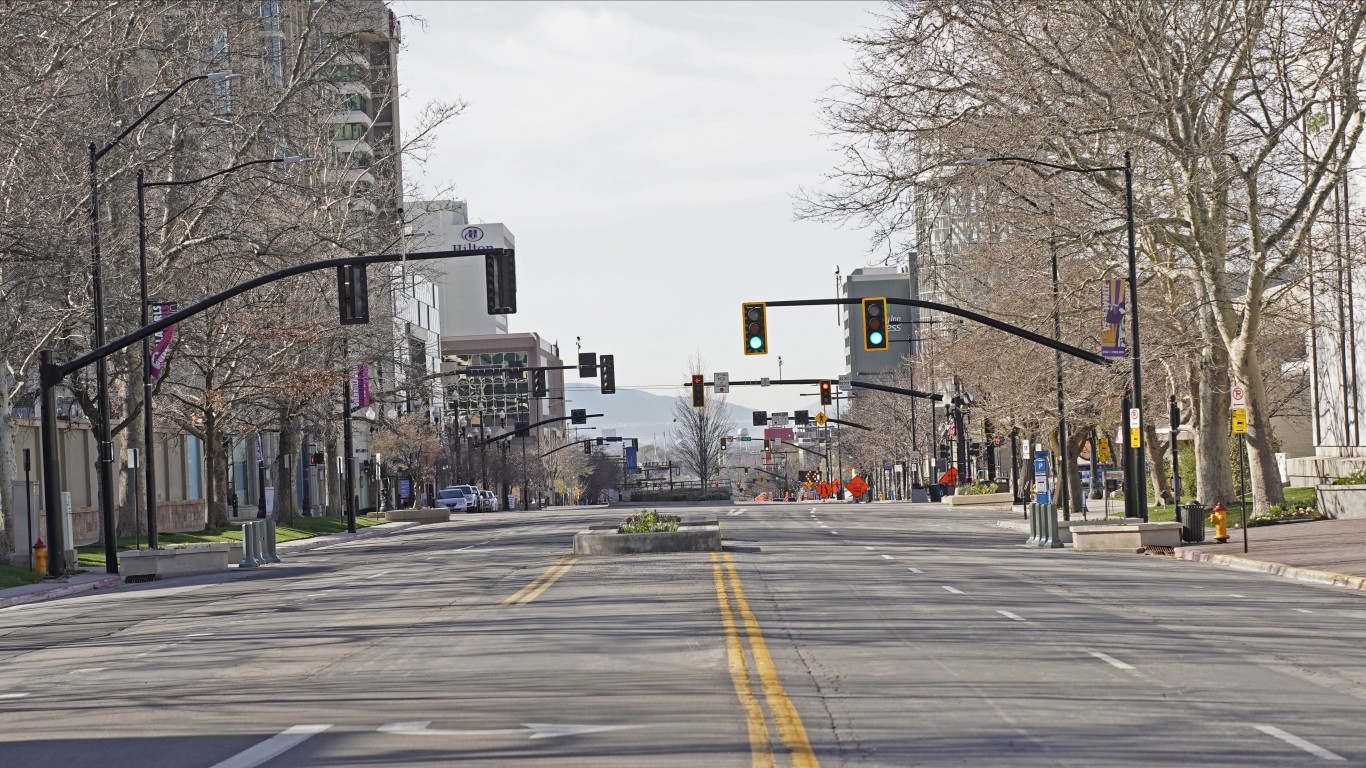
Utah
> Confirmed COVID-19 cases as of April 29: 137 per 100,000 — 23rd lowest (total: 4,343)
> COVID-19 related deaths as of April 29: 1 per 100,000 — 6th lowest (total: 45)
> Tests as of April 29: 3,241 per 100,000 — 5th highest (total: 102,439)
> Days between first case on 2/25/2020 and statewide stay-at-home effective date: No order issued as of Apr. 29
> Population: 3,161,105
There was no statewide stay-at-home order as of April 28, but several counties have issued one, including Salt Lake County. A “Stay Safe Stay Home” directive is in effect through the end of this month. Diners and eateries can now allow customers inside to pick up orders — as long as they stay 6 feet away from each other. Some counties’ individual health orders remain more restrictive than the state’s. Statewide restrictions on elective surgeries and procedures were lifted as of April 21.

Vermont
> Confirmed COVID-19 cases as of April 29: 133 per 100,000 — 22nd lowest (total: 834)
> COVID-19 related deaths as of April 29: 8 per 100,000 — 17th highest (total: 47)
> Tests as of April 29: 2,285 per 100,000 — 14th highest (total: 14,310)
> Days between first case on 3/7/2020 and statewide stay-at-home effective date (3/24/2020): 17
> Population: 626,299
A stay-at-home order is in effect until at least May 15. Schools are closed through the rest of the academic year. Residents can only leave their homes for essential reasons such as personal safety, groceries or medicine, curbside pick-up of goods, and a few others. Everyone has to work remotely when possible. Some “low contact” businesses can open after April 20 with a two-person staff.
[in-text-ad-2]
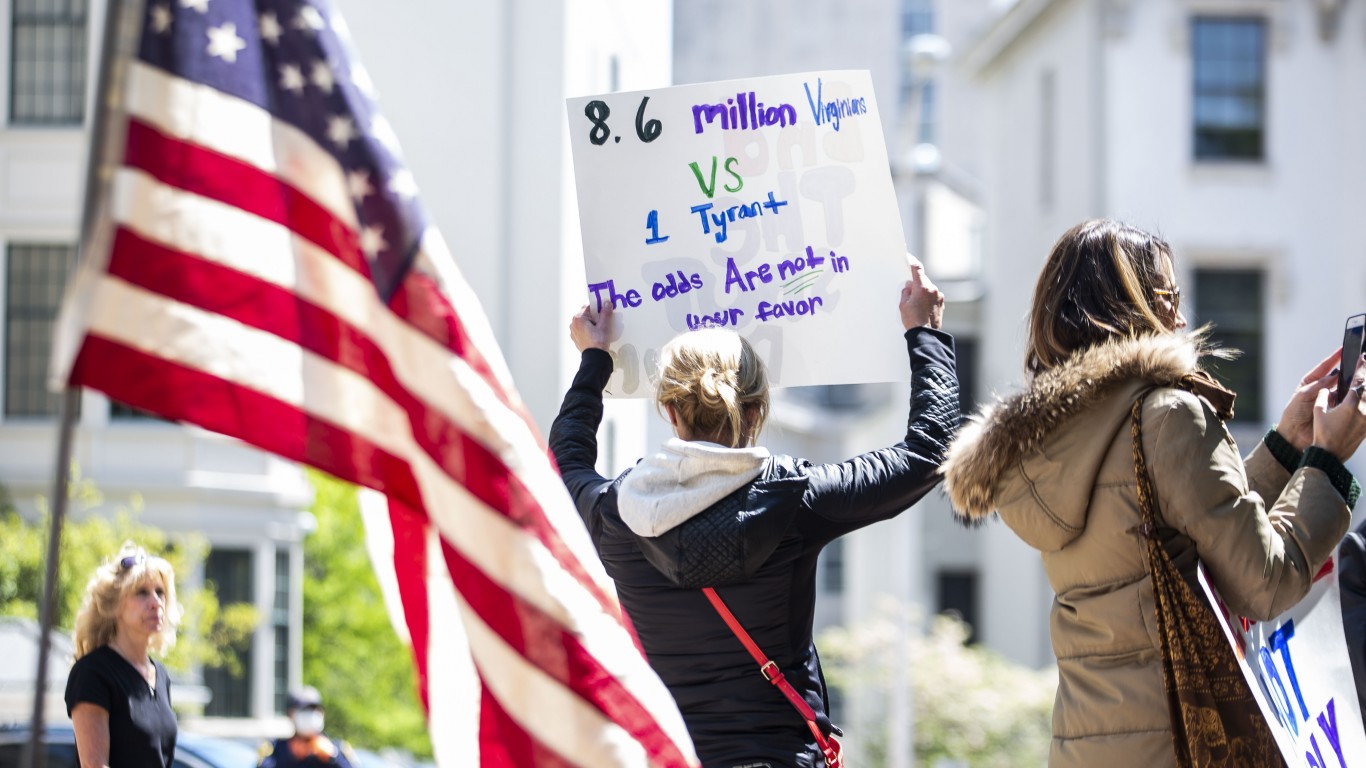
Virginia
> Confirmed COVID-19 cases as of April 29: 176 per 100,000 — 19th highest (total: 14,961)
> COVID-19 related deaths as of April 29: 6 per 100,000 — 20th highest (total: 522)
> Tests as of April 29: 1,002 per 100,000 — 2nd lowest (total: 85,307)
> Days between first case on 3/7/2020 and statewide stay-at-home effective date (3/30/2020): 23
> Population: 8,517,685
A stay-at-home order is in effect until June 10. It’s unlawful to gather in groups of 10 or more people. Those violating social distancing rules can be charged with a misdemeanor, which carries the possibility of jail time up to 12 months and a fine of up to $2,500. Essential businesses are closed at least until May 8. Beaches are closed statewide except for fishing and exercise. All K-12 schools are closed through the rest of the school year.
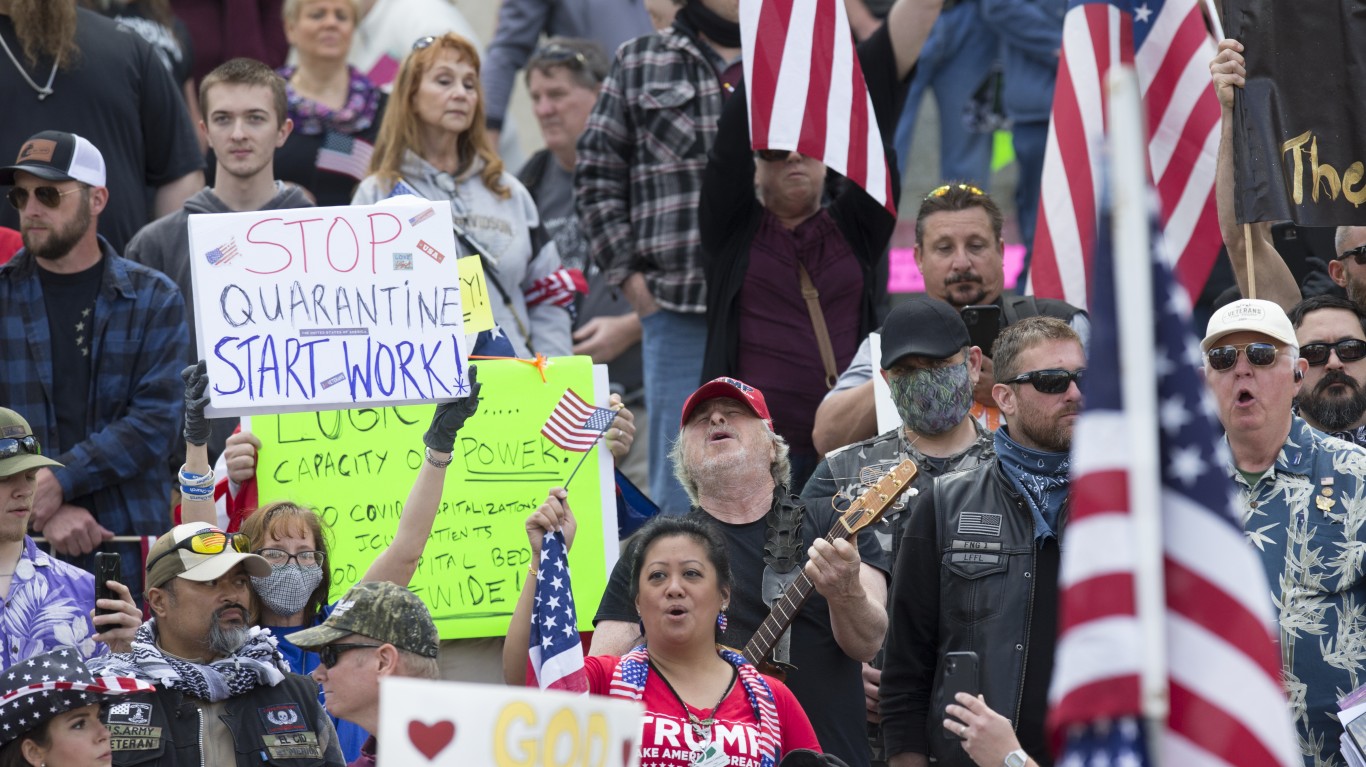
Washington
> Confirmed COVID-19 cases as of April 29: 184 per 100,000 — 18th highest (total: 13,842)
> COVID-19 related deaths as of April 29: 10 per 100,000 — 14th highest (total: 786)
> Tests as of April 29: 2,422 per 100,000 — 9th highest (total: 182,515)
> Days between first case on 1/21/2020 and statewide stay-at-home effective date (3/23/2020): 62
> Population: 7,535,591
A stay-at-home order is in effect until May 4. The governor is expected to extend it or at least keep most of the restrictions in place. All gatherings for social, spiritual, and recreational purposes are banned. Only essential businesses are allowed to remain open. People can still go on bike rides, garden, and walk the dogs as long as they follow social distancing rules. Sports courts and playgrounds are closed. All K-12 schools are closed for the rest of the school year.
[in-text-ad]
West Virginia
> Confirmed COVID-19 cases as of April 29: 61 per 100,000 — 5th lowest (total: 1,095)
> COVID-19 related deaths as of April 29: 2 per 100,000 — 8th lowest (total: 38)
> Tests as of April 29: 2,300 per 100,000 — 13th highest (total: 41,526)
> Days between first case on 3/17/2020 and statewide stay-at-home effective date (3/24/2020): 7
> Population: 1,805,832
A stay-at-home order is in effect until further notice. Out-of-state citizens must self-quarantine for 14 days. If people fail to comply they may be fined up to $500 or imprisoned for up to a year. Elective medical procedures resumed on April 28. Small businesses, outdoor seating at restaurants, barber shops, nail salons, and church and funeral services can resume services.

Wisconsin
> Confirmed COVID-19 cases as of April 29: 108 per 100,000 — 15th lowest (total: 6,289)
> COVID-19 related deaths as of April 29: 5 per 100,000 — 25th highest (total: 300)
> Tests as of April 29: N/A
> Days between first case on 2/5/2020 and statewide stay-at-home effective date (3/25/2020): 49
> Population: 5,813,568
All individuals present within the state are ordered to stay home or at their place of residence, with few exceptions. All but essential travel is prohibited. Violation or obstruction of the order is punishable by up to 30 days imprisonment, or up to $250 fine, or both. The order is in effect at least until at least May 26. Some nonessential businesses, including outdoor recreational rentals, are allowed to reopen but are barred from direct contact with customers. Curbside drop-off of goods and animals is now allowed.

Wyoming
> Confirmed COVID-19 cases as of April 29: 67 per 100,000 — 6th lowest (total: 389)
> COVID-19 related deaths as of April 29: 1 per 100,000 — 2nd lowest (total: 7)
> Tests as of April 29: N/A
> Days between first case on 3/11/2020 and statewide stay-at-home effective date: No order issued as of Apr. 29
> Population: 577,737
There was no statewide stay-at-home order as of April 28. All places of public accommodation are closed except for the children of essential workers. Drive-thru, delivery, and pickup only services allowed. Schools, colleges, and trade schools are closed. Anyone returning to the state from any other state or country must self-quarantine for 14 days.
Methodology
To determine every state’s rules on social distancing and restrictions on movement, 24/7 Wall St. reviewed each state’s governor executive orders since the first COVID-19 case was confirmed in the United States at the end of January.
Data on COVID-19 confirmed cases and related deaths came from the Centers for Disease Control and Prevention as well as from state and local health departments. The number of COVID-19 tests every state has conducted as of April 29 also came from state and local health departments.
Retirement planning doesn’t have to feel overwhelming. The key is finding professional guidance—and we’ve made it easier than ever for you to connect with the right financial advisor for your unique needs.
Here’s how it works:
1️ Answer a Few Simple Questions
Tell us a bit about your goals and preferences—it only takes a few minutes!
2️ Get Your Top Advisor Matches
This tool matches you with qualified advisors who specialize in helping people like you achieve financial success.
3️ Choose Your Best Fit
Review their profiles, schedule an introductory meeting, and select the advisor who feels right for you.
Why wait? Start building the retirement you’ve always dreamed of. Click here to get started today!
Thank you for reading! Have some feedback for us?
Contact the 24/7 Wall St. editorial team.